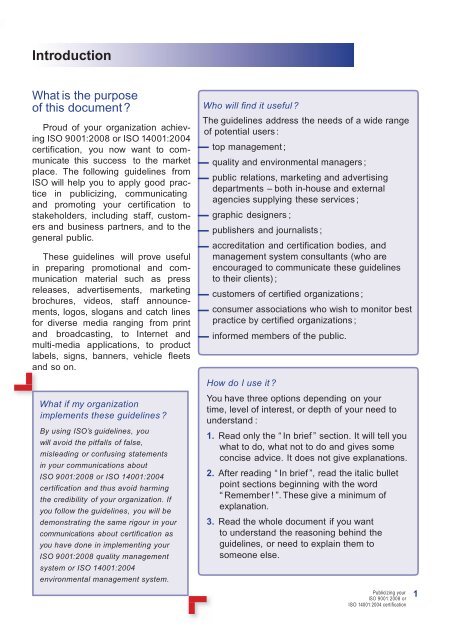publicizing iso9001 iso14001 certification 2010
publicizing iso9001 iso14001 certification 2010
publicizing iso9001 iso14001 certification 2010
You also want an ePaper? Increase the reach of your titles
YUMPU automatically turns print PDFs into web optimized ePapers that Google loves.
Introduction<br />
What is the purpose<br />
of this document ?<br />
Proud of your organization achiev-<br />
ing ISO 9001:2008 or ISO 14001:2004<br />
<strong>certification</strong>, you now want to com-<br />
municate this success to the market<br />
place. The following guidelines from<br />
ISO will help you to apply good prac-<br />
tice in <strong>publicizing</strong>, communicating<br />
and promoting your <strong>certification</strong> to<br />
stakeholders, including staff, custom-<br />
ers and business partners, and to the<br />
general public.<br />
These guidelines will prove useful<br />
in preparing promotional and com-<br />
munication material such as press<br />
releases, advertisements, marketing<br />
brochures, videos, staff announce-<br />
ments, logos, slogans and catch lines<br />
for diverse media ranging from print<br />
and broadcasting, to Internet and<br />
multi-media applications, to product<br />
labels, signs, banners, vehicle fleets<br />
and so on.<br />
What if my organization<br />
implements these guidelines ?<br />
By using ISO’s guidelines, you<br />
will avoid the pitfalls of false,<br />
misleading or confusing statements<br />
in your communications about<br />
ISO 9001:2008 or ISO 14001:2004<br />
<strong>certification</strong> and thus avoid harming<br />
the credibility of your organization. If<br />
you follow the guidelines, you will be<br />
demonstrating the same rigour in your<br />
communications about <strong>certification</strong> as<br />
you have done in implementing your<br />
ISO 9001:2008 quality management<br />
system or ISO 14001:2004<br />
environmental management system.<br />
Who will find it useful ?<br />
The guidelines address the needs of a wide range<br />
of potential users :<br />
top management ;<br />
quality and environmental managers ;<br />
public relations, marketing and advertising<br />
departments – both in-house and external<br />
agencies supplying these services ;<br />
graphic designers ;<br />
publishers and journalists ;<br />
accreditation and <strong>certification</strong> bodies, and<br />
management system consultants (who are<br />
encouraged to communicate these guidelines<br />
to their clients) ;<br />
customers of certified organizations ;<br />
consumer associations who wish to monitor best<br />
practice by certified organizations ;<br />
informed members of the public.<br />
How do I use it ?<br />
You have three options depending on your<br />
time, level of interest, or depth of your need to<br />
understand :<br />
1. Read only the “ In brief ” section. It will tell you<br />
what to do, what not to do and gives some<br />
concise advice. It does not give explanations.<br />
2. After reading “ In brief ”, read the italic bullet<br />
point sections beginning with the word<br />
“ Remember ! ”. These give a minimum of<br />
explanation.<br />
3. Read the whole document if you want<br />
to understand the reasoning behind the<br />
guidelines, or need to explain them to<br />
someone else.<br />
Publicizing your 1<br />
ISO 9001: 2008 or<br />
ISO 14001:2004 <strong>certification</strong>


